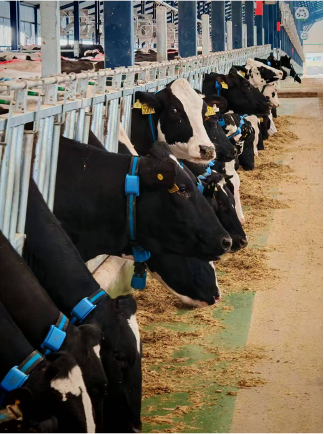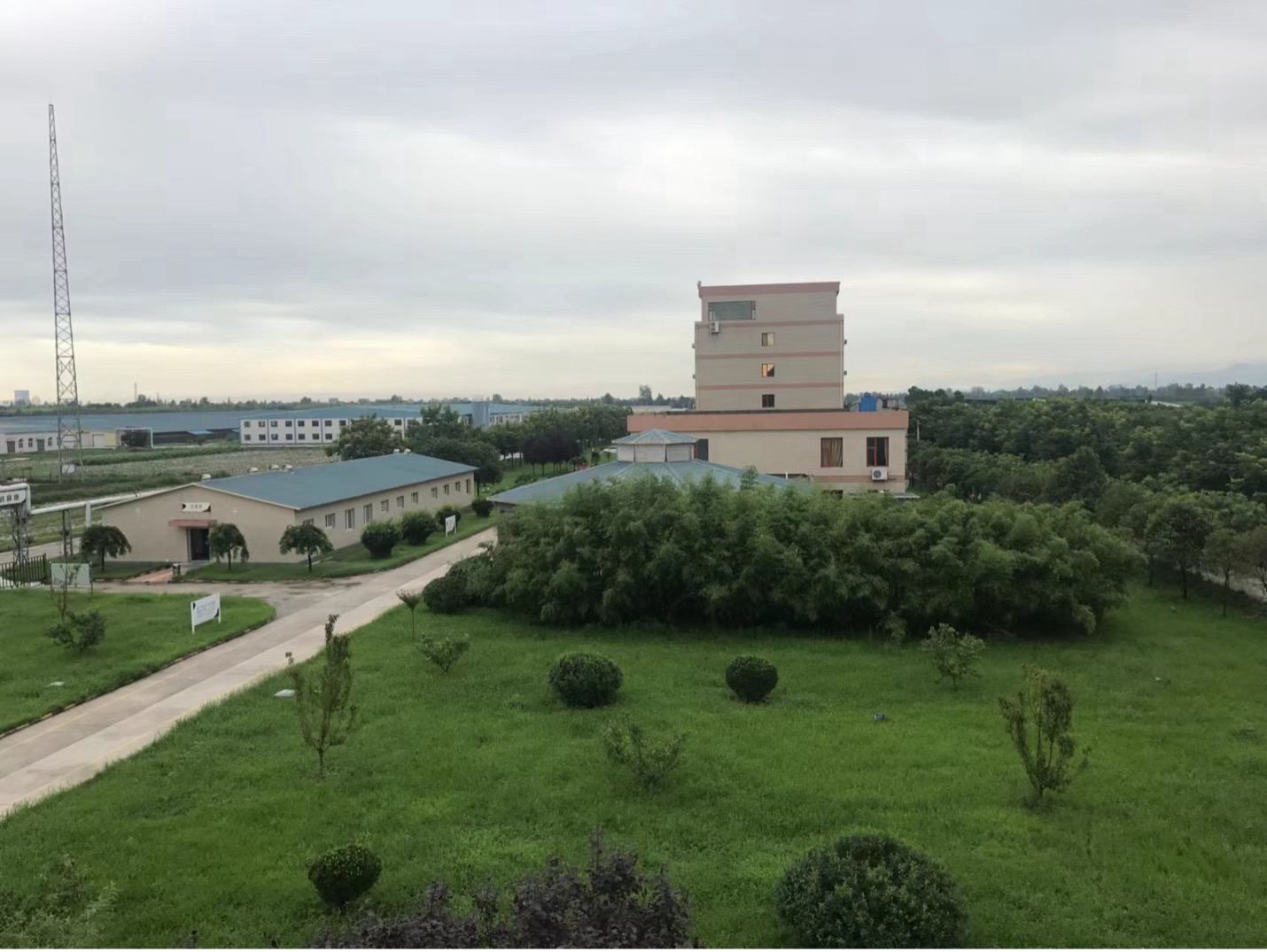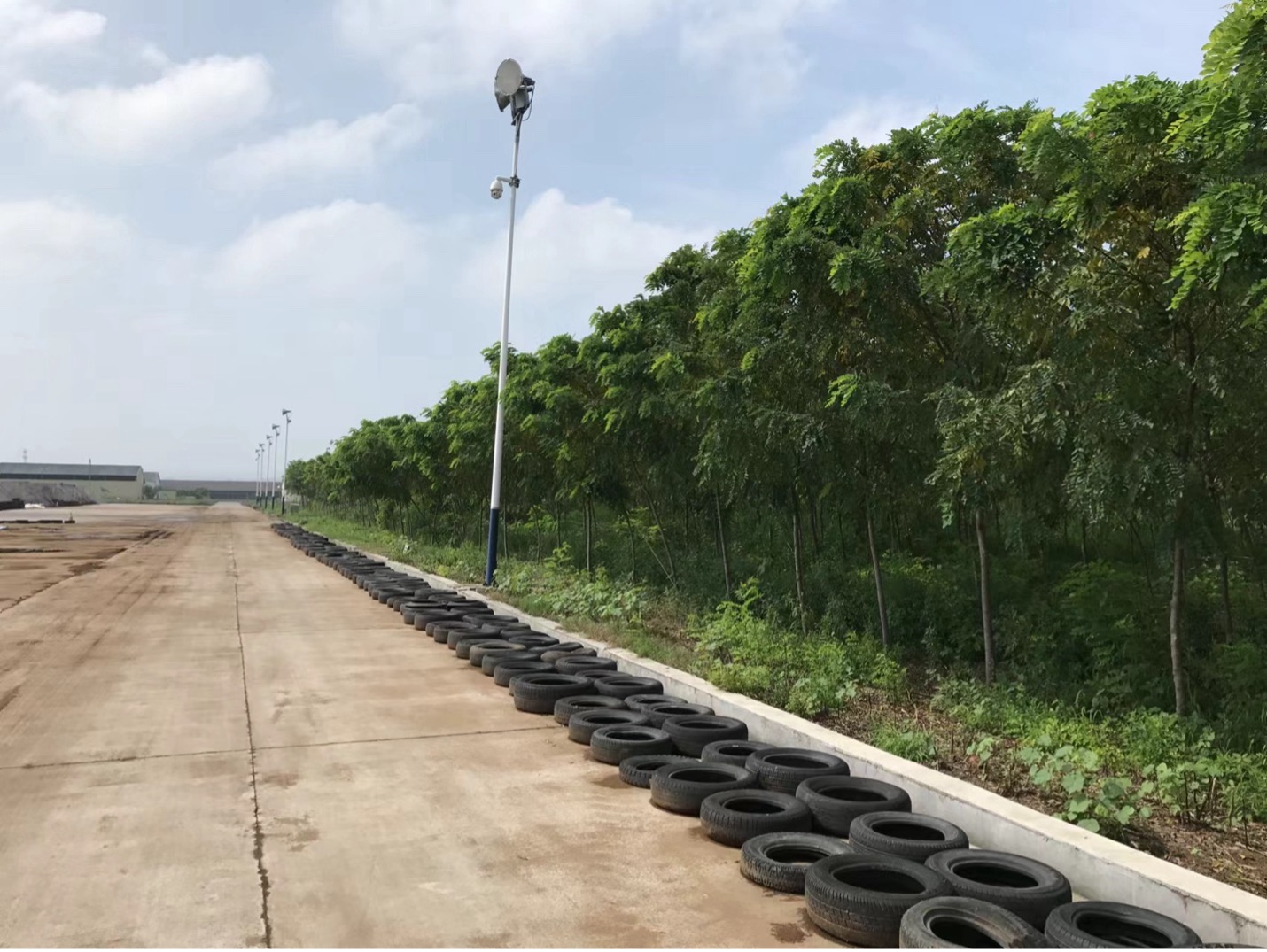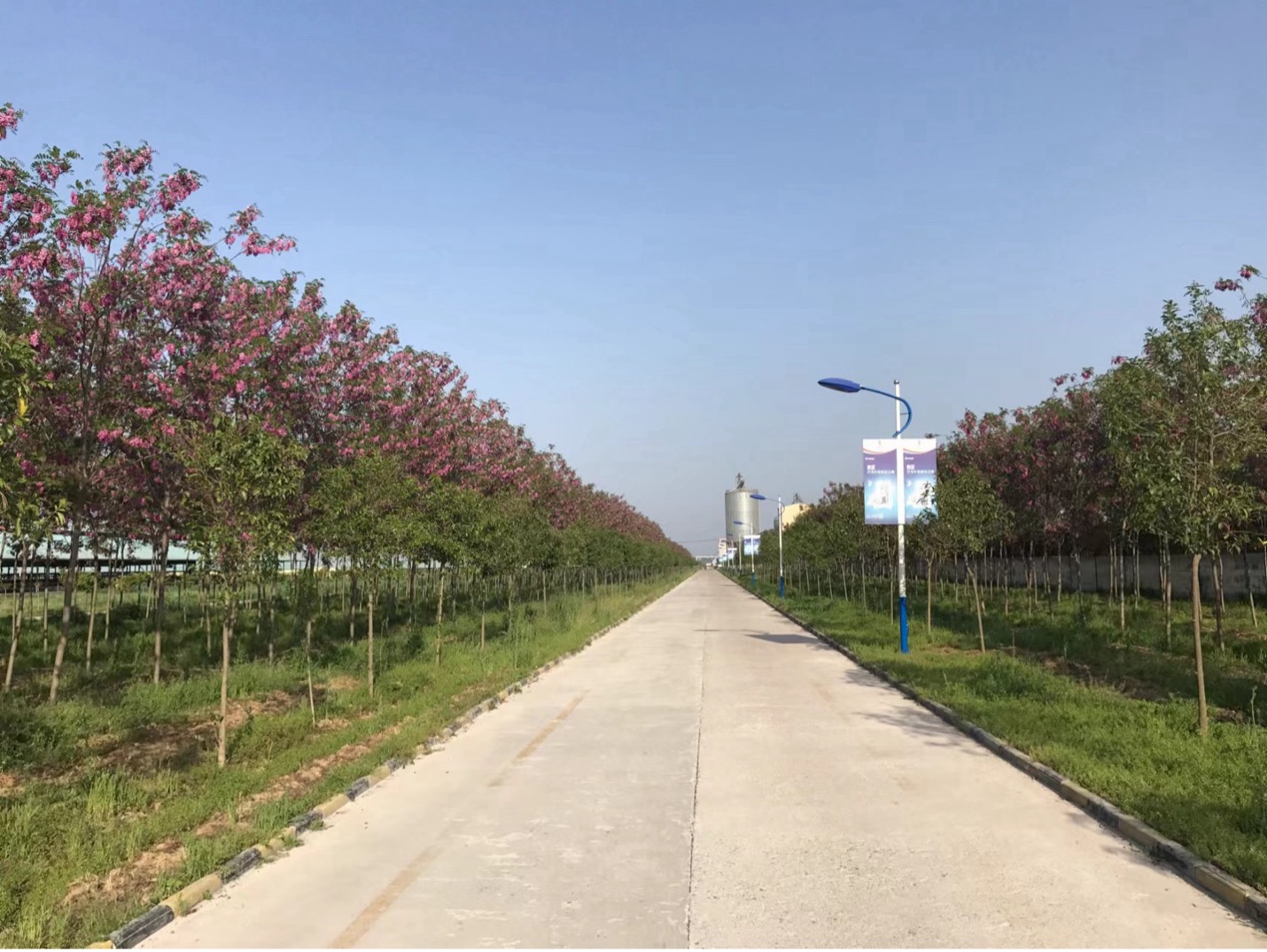Modern Dairy Carbon Emission Targets and Practices
Modern Dairy launched the dual-carbon plan and set a quantitative target for carbon intensity emissions by 2035. Modern Dairy listed the ultra-large-scale farms and super-large-scale farms with low carbon emission intensity as the “carbon emission” model and star. “Energy saving and emission reduction” is incorporated into the strategic planning, aiming to provide a strong basis for the coordinated development of low-carbon and quality improvement and efficiency enhancement, and boost the confidence of the industry’s sustainable development.
The Company has set greenhouse gas (GHG) emission reduction targets and energy conservation and consumption reduction targets, and monitors the progress of these targets regularly.
1. Carbon Emission Targets and Progress
Section titled “1. Carbon Emission Targets and Progress”The Company has established greenhouse gas Scope 1 and Scope 2 emission reduction targets that cover the Group and all its consolidated subsidiaries, encompassing key business units such as dairy farming, forage planting, feed processing and sales, and breeding. These targets are uniformly incorporated into the Group’s carbon management framework for centralized management. By promoting coordinated emission reduction actions across various business sectors, the Company achieves comprehensive coverage of climate actions at the Group level, supporting the implementation of its green and low-carbon development strategic objectives.
1.1 Target for Carbon Emission per Kilogram of FPCM
Carbon emission per kilogram of FPCM in 2021 (base year): 0.91 kg CO2e/kg FPCM
- Taking 2021 as the base year, by the end of 2025, the Group’s carbon emission per kilogram of FPCM will be reduced by 7% to 0.85 kg CO2e/kg FPCM;
- Taking 2021 as the base year, by the end of 2030, the Group’s carbon emission per kilogram of FPCM will be reduced by 15% to 0.77 kg CO2e/kg FPCM;
- Taking 2021 as the base year, by the end of 2035, the Group’s carbon emission per kilogram of FPCM will be reduced by 20% to 0.73 kg CO2e/kg FPCM.
Among them, by the end of 2025,
- Achieve a 3% reduction in carbon emissions per kilogram of FPCM by improving feed digestibility to reduce GHG emissions from enteric fermentation and manure management;
- Achieve a 1% reduction in carbon emissions per kilogram of FPCM by optimizing the cattle herd structure, reducing calving intervals, and increasing the proportion of milkable cows;
- Achieve a 1.5% reduction in carbon emissions per kilogram of FPCM by upgrading energy facilities, implementing energy-saving measures, enhancing energy utilization efficiency, optimizing energy structure, and increasing the proportion of green energy sources;
- Achieve a 1.5% reduction in carbon emissions per kilogram of FPCM by optimizing manure management practices to reduce GHG emissions from the process.
Target Progress:
- In 2024, the Company’s carbon emissions per kilogram of FPCM (0.87 kg CO2e/kg FPCM) decreased by 4.8% compared to 2021
1.2 Target for Methane Emission per FPCM
Methane emission per kilogram of FPCM in 2021 (base year): 0.67 kg CO2e/kg FPCM
- Taking 2021 as the base year, by the end of 2025, the Group’s methane emission per kilogram of FPCM will be reduced by 5.8%.
Among them, by the end of 2025,
- Achieve a 3% reduction in methane emissions per kilogram of FPCM by improving feed digestibility to reduce enteric fermentation methane emissions by 2.6% and manure management methane emissions by 5.2%;
- Achieve a 1% reduction in methane emissions per kilogram of FPCM by optimizing the cattle herd structure, reducing calving intervals, and increasing the proportion of milkable cows;
- Achieve a 1.8% reduction in methane emissions per kilogram of FPCM by optimizing manure management practices to reduce methane emissions from this process by 7.9%.
Target Progress:
- In 2024, the Company’s methane emissions per FPCM (0.64 kg CO2e/kg FPCM) decreased by 4.8% compared to 2021
1.3 GHG Emissions KPIs1:
- Greenhouse Gas Scope1 and Scope 2 Emissions
| Year | Livestock Business Scope 1 and 2 Emissions (000 tCO2e) | Feed Production Business Scope 1 and 2 Emissions (t CO2e) |
|---|---|---|
| 2021 | 1,331.70 | 1,002.162 |
| 2022 | 2,057.60 | 7,237.47 |
| 2023 | 2,301.96 | 7,353.49 |
| 20243 | 2,599.66 | 2,308.70 |
- Greenhouse Gas Scope 3 Emissions
| Emissions Source Category | Emissions(t CO2e) | |
|---|---|---|
| 2024 | 2023 | |
| Upstream Transportation and Distribution | 223,572 | 182,513 |
| Waste Generated in Operations | 58,134 | 68,450 |
| Business Travel | 1,320 | 1,300 |
| Employee Commuting | 5,969 | 9,024 |
| Total | 288,995 | 261,287 |
Note 1:
- The accounting methodology used for Scope 1 and Scope 2 is the “2019 Refinement to the 2006 IPCC Guidelines for National Greenhouse Gas Inventories.” The accounting and disclosure boundaries are based on ISO 14064-1:2018 “Greenhouse gases – Part 1: Specification with guidance at the organization level for quantification and reporting of greenhouse gas emissions and removals.”
- The Scope 1 and Scope 2 carbon emissions for 2020-2024 have all undergone greenhouse gas emission verification by China Classification Society, obtaining ISO 14064-1:2018 standard certification for four consecutive years. After document review and on-site visits, the verification team prepared and submitted the greenhouse gas emission verification report. This report undergoes technical review by personnel independent of the verification team and possessing relevant professional knowledge; only after approval can it be reviewed and endorsed.
- The accounting and disclosure boundaries for Scope 3 are based on the GHG Protocol “Corporate Accounting and Reporting Standard.”
Note 2: In 2021, the Scope 1 and Scope 2 emissions from Modern Dairy’s feed production business only included data from the Shanghe Farm feed mill. Emission data from all associated pelletizing plants were accounted for uniformly within their respective farms.
Note 3: In 2024, due to the optimization of the company’s energy management structure and adjustments to the electricity metering system, emission data from pelletizing plants were included in the statistical scope of the farm business (i.e., livestock business).
2. Energy Conservation and Emission Reduction Practices
Section titled “2. Energy Conservation and Emission Reduction Practices”In 2025, Modern Dairy continued to advance energy conservation and emission reduction efforts, achieving significant progress in areas such as renewable energy utilization, operational efficiency improvement, and smart agriculture emission reduction. As of November 30, 2025, the Company’s energy conservation and emission reduction performance is as follows:
- Proportion of Renewable Energy Use: Renewable energy accounted for 58% of the Group’s total energy consumption.
- Comprehensive Effectiveness of Photovoltaic (PV) Power Generation:
- Overall Construction and Contribution: The Group has cumulatively built PV projects with an installed capacity of 98.5 MW, facilitating approximately RMB 369 million in local investment and realizing over RMB 7 million in annual local tax payments. The PV projects generate approximately 130 million kWh of green electricity annually, saving about 42,900 tons of standard coal and reducing CO₂e emissions by approximately 108,000 tons per year.
- Farm Specific Use: Farm PV power consumption reached 7.08 million kWh, replacing 2,200 tons of standard coal and reducing CO₂e emissions by 6,000 tons.
- Biogas Resource Utilization: Farm biogas consumption reached 164 million cubic meters (total production: 182 million cubic meters), replacing 117,000 tons of standard coal and reducing CO₂e emissions by 1.64 million tons.
- Biogas Capacity Enhancement: Newly constructed anaerobic fermentation tanks reached 47,000 cubic meters, reducing CO₂e emissions by 6,000 tons.
2.1 Clean Energy
- Renewable Energy Photovoltaic (PV) Power Generation: As of November 30, 2025, the Company’s accumulated grid-connected PV installed capacity reached 98.5 MW, with 80 MW newly added in 2025. The 40 MW rooftop PV project at Tangshan Farm, one of the key projects of the year, was successfully connected to the grid in 2025. It is expected to generate approximately 48 million kWh of electricity annually, replacing about 14,000 tons of standard coal per year and reducing carbon dioxide emissions by approximately 37,000 tons.

The 40 MW photovoltaic power project at Tangshan Farm has been officially connected to the grid
-
Biogas Resource Utilization: We are committed to converting organic waste, such as cow manure, into valuable energy and resources to maximize the reduction of greenhouse gas (GHG) emissions and achieve resource recycling. Through the anaerobic fermentation system, the liquid digestate produced is used as fertilizer for field return, while the solid digestate is used as cattle bedding. The biogas produced is utilized for multiple purposes: 1) Generating steam for heating in farm production operations; 2) Combustion for drying solid digestate to be used as bedding; 3) Power generation—after meeting the farm’s own electricity needs, excess power is supplied to the grid to generate extra revenue. Currently, 19 of the Company’s farms are equipped with anaerobic fermentation systems, 12 of which have achieved biogas power generation. In 2025, the Company advanced the expansion of anaerobic fermentation tanks at Baoji, Tongliao, and Chabei farms, and added biological desulfurization systems at Shuangcheng, Chabei, and Tongliao farms. These measures improve biogas quality, yield, and utilization efficiency, further reducing dependence on fossil fuels and lowering GHG emissions. Additionally, through cooperation with third parties, the Company added 10 imported generator sets with a total installed capacity of 19.2 MW. The Company adopts the Combined Heat and Power (CHP) mode for generation, recovering waste heat from flue gas to dry solid digestate, thereby further enhancing energy efficiency. In 2024, biogas production reached 194 million cubic meters, and biogas power generation totaled 107 million kWh. A total of 1.75 million cubic meters of biogas residue bedding was dried using new energy and waste heat, while 9.74 million cubic meters of biogas slurry was produced. From January to November 2025, biogas production stood at 182 million cubic meters, with power generation reaching 112 million kWh. The volume of biogas residue bedding dried using new energy and waste heat reached 1.92 million cubic meters, and 9.40 million cubic meters of biogas slurry was produced.
-
Electrification of Operating Equipment: The Company continues to promote the electrification of on-site operating equipment, gradually reducing the procurement of new diesel-powered machinery and prioritizing electric solutions. As of December 12, 2025, a total of 259 pieces of electric equipment, including electric loaders, electric forklifts, stationary mixing tanks, and fresh milk transport trucks, have been put into use across the Company’s farms. Among them, the application of 50 new energy loaders has shown significant results; each unit is expected to reduce CO2 equivalent emissions by 60 tons annually and save approximately RMB 100,000 in operating costs. Meanwhile, we are actively piloting new equipment such as electric tractors and electric dump trucks with partners to gradually expand the coverage of electric equipment and continuously increase the electrification rate of operating machinery.
-
Air Energy Heating Replacement: The Company uses air energy instead of biomass boilers for heating, reducing greenhouse gas emissions while conserving fuel use. In 2025, the Company added 8 sets of air energy equipment for heating and hot water supply, and gradually replaced boilers at 7 farms.
2.2 Other Energy Saving and Emission Reduction Measures
- Optimization of Biogas Utilization via Horizontal Decanter Centrifuges: By adopting horizontal decanter centrifuge technology, we have effectively improved biogas utilization efficiency and significantly reduced reliance on external biomass fuels. This technology involves pre-heating the solid digestate and then using the centrifuge to reduce its moisture content, thereby lowering the biogas consumption required for drying. Previously, when biogas was insufficient, we needed to burn biomass pellets to supplement energy. At this stage, thanks to the biogas saved, our procurement volume of biomass has dropped by 50% year-on-year. In 2024, we installed horizontal decanter centrifuges in 10 farms equipped with anaerobic fermentation systems.
- Yunyangniu Smart Collars Aid Emission Reduction: In 2025, we promoted the use of over 180,000 sets of Yunyangniu (raising cattle on the cow) smart collars across our farms. This device monitors cows’ key physiological data in real-time, helping to reduce methane emissions while improving production efficiency. Following the installation of smart collars, 31 farms have completely ceased traditional tail painting and manual heat detection methods. Through real-time data feedback from the system, we can quickly and accurately identify the estrus period of cows and optimize breeding timing, thereby improving the conception rate. Since using smart collars, the 21-day pregnancy rate has increased by 3.9%, and the 21-day insemination rate has increased by 6.7% compared to before. Since non-pregnant cows (dry cows) do not produce milk but still emit methane, shortening the open period directly reduces methane emissions per unit of milk production over the entire lifecycle. In addition, relying on the collar system combined with milk yield measurement and smart grouping technology, we have achieved early detection and timely intervention for cow diseases. Maintaining cow health helps improve milk production efficiency, which further reduces methane emissions per unit of milk produced.

Successful rollout of 180,000 Yunyangniu smart collars
3. Farm Beautification and Carbon Sequestration Project
Section titled “3. Farm Beautification and Carbon Sequestration Project”To beautify the farm environment and achieve carbon sequestration goals, by the end of 2025, Modern Dairy had planted extensive crops and trees on vacant land within its farms. The project covers 23 farms, accounting for 43% of the total. The total tree planting area reached 968 mu (approx. 64.5 hectares), featuring species such as pine, willow, elm, and poplar. notably, the Ulan Buh Organic Region farms, located in the hinterland of the desert, launched a comprehensive greening project in the spring of 2025. This initiative covered a cumulative greening area of over 200 mu, with over 430,000 drought-resistant and sand-fixing plants planted, including elms, roses, Malan flowers, and lilacs, playing a positive ecological role in windbreak, sand fixation, and soil and water conservation.
Tree planting not only helps improve the ecological environment but also absorbs carbon dioxide and releases oxygen through photosynthesis, thereby achieving carbon sequestration. In addition, the planted trees provide multiple ecological benefits, such as:
- Improving Air Quality: Trees absorb pollutants from the air and release fresh oxygen through photosynthesis.
- Soil and Water Conservation: Tree root systems fix soil, reducing soil erosion and preventing land degradation.
- Enhancing Biodiversity: Trees provide habitats for various animals and plants, promoting the diversity and stability of the ecosystem.
In the future, Modern Dairy plans to further expand the scale of carbon sequestration projects, expecting to promote this practice in more farms to achieve higher environmental benefits and social value.



Baoji Fram

